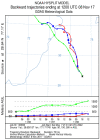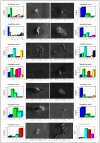Physico-Chemical Properties and Deposition Potential of PM2.5 during Severe Smog Event in Delhi, India
- PMID: 36430104
- PMCID: PMC9690713
- DOI: 10.3390/ijerph192215387
Physico-Chemical Properties and Deposition Potential of PM2.5 during Severe Smog Event in Delhi, India
Abstract
The present work studies a severe smog event that occurred in Delhi (India) in 2017, targeting the characterization of PM2.5 and its deposition potential in human respiratory tract of different population groups in which the PM2.5 levels raised from 124.0 µg/m3 (pre-smog period) to 717.2 µg/m3 (during smog period). Higher concentration of elements such as C, N, O, Na, Mg, Al, Si, S, Fe, Cl, Ca, Ti, Cr, Pb, Fe, K, Cu, Cl, P, and F were observed during the smog along with dominant organic functional groups (aldehyde, ketones, alkyl halides (R-F; R-Br; R-Cl), ether, etc.), which supported potential contribution from transboundary biomass-burning activities along with local pollution sources and favorable meteorological conditions. The morphology of individual particles were found mostly as non-spherical, including carbon fractals, aggregates, sharp-edged, rod-shaped, and flaky structures. A multiple path particle dosimetry (MPPD) model showed significant deposition potential of PM2.5 in terms of deposition fraction, mass rate, and mass flux during smog conditions in all age groups. The highest PM2.5 deposition fraction and mass rate were found for the head region followed by the alveolar region of the human respiratory tract. The highest mass flux was reported for 21-month-old (4.7 × 102 µg/min/m2), followed by 3-month-old (49.2 µg/min/m2) children, whereas it was lowest for 21-year-old adults (6.8 µg/min/m2), indicating babies and children were more vulnerable to PM2.5 pollution than adults during smog. Deposition doses of toxic elements such as Cr, Fe, Zn, Pb, Cu, Mn, and Ni were also found to be higher (up to 1 × 10-7 µg/kg/day) for children than adults.
Keywords: PM2.5; chemical composition; deposition potential; health effects; morphology; smog.
Conflict of interest statement
The authors declare no conflict of interest.
Figures






Similar articles
-
Elemental Composition and Sources of Fine Particulate Matter (PM2.5) in Delhi, India.Bull Environ Contam Toxicol. 2023 Mar 9;110(3):60. doi: 10.1007/s00128-023-03707-7. Bull Environ Contam Toxicol. 2023. PMID: 36892662 Free PMC article.
-
[Concentration distribution of metal elements in atmospheric aerosol under different weather conditions in Qingdao Coastal Region].Huan Jing Ke Xue. 2014 Oct;35(10):3651-62. Huan Jing Ke Xue. 2014. PMID: 25693366 Chinese.
-
Characterization of PM10 and PM2.5 and associated heavy metals at the crossroads and urban background site in Zabrze, Upper Silesia, Poland, during the smog episodes.Environ Monit Assess. 2010 Sep;168(1-4):613-27. doi: 10.1007/s10661-009-1138-8. Epub 2009 Sep 16. Environ Monit Assess. 2010. PMID: 19757124
-
Chemical characteristics and source apportionment of PM2.5 using PCA/APCS, UNMIX, and PMF at an urban site of Delhi, India.Environ Sci Pollut Res Int. 2017 Jun;24(17):14637-14656. doi: 10.1007/s11356-017-8925-5. Epub 2017 Apr 28. Environ Sci Pollut Res Int. 2017. PMID: 28455568
-
PM2.5 pollution from household solid fuel burning practices in central India: 1. Impact on indoor air quality and associated health risks.Environ Geochem Health. 2017 Oct;39(5):1045-1058. doi: 10.1007/s10653-016-9871-8. Epub 2016 Sep 10. Environ Geochem Health. 2017. PMID: 27614876
References
-
- de Leeuw F.A.A.M., Moussiopoulos N., Sahm P., Bartonova A. Urban air quality in larger conurbations in the European Union. Environ. Model. Softw. 2001;16:399–414. doi: 10.1016/S1364-8152(01)00007-X. - DOI
-
- Angyal1 A., Ferenczi Z., Manousakas M., Furu1 E., Szoboszlai1 Z., Török Z., Papp E., Szikszai1 Z., Kertész Z. Source identification of fine and coarse aerosol during smog episodes in Debrecen, Hungary. Air Qual. Atmos. Health. 2021;14:1017–1032. doi: 10.1007/s11869-021-01008-8. - DOI
-
- Mikušaka P., Křůmal K., Večeřa Z. Characterization of organic compounds in the PM2.5 aerosols in winter in an industrial urban area. Atmos. Environ. 2015;105:97–108. doi: 10.1016/j.atmosenv.2015.01.028. - DOI
-
- Kanawade V.P., Srivastava A.K., Ram K., Asmi E., Vakkari V., Soni V.K., Varaprasad V., Sarangi C. What caused severe air pollution episode of November 2016 in New Delhi? Atmos. Environ. 2020;222:117125. doi: 10.1016/j.atmosenv.2019.117125. - DOI
-
- Sawlani R., Agnihotri R., Sharma C., Patra P.K., Dimri A.P., Ram K., Verma R.L. The severe Delhi SMOG of 2016: A case of delayed crop residue burning, coincident firecracker emissions, and atypical meteorology. Atmos. Pollut. Res. 2019;10:868–879. doi: 10.1016/j.apr.2018.12.015. - DOI
MeSH terms
Substances
LinkOut - more resources
Full Text Sources

